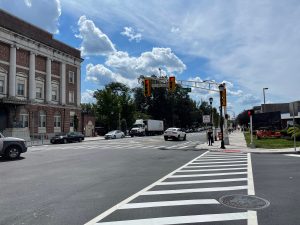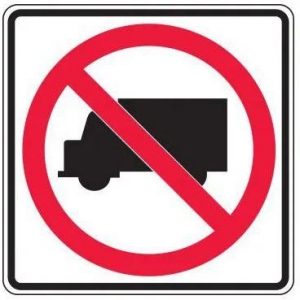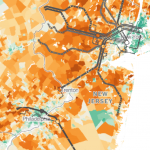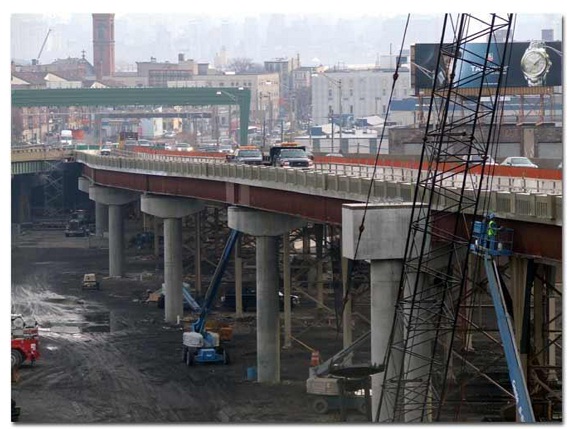New Jersey Future Blog
“Complete Streets” and Goods Delivery: What Is a Street For?
March 24th, 2022 by Tim Evans

Photo Credit: Bailey Lawrence
The changing nature of shopping means people are more likely to have things delivered to them than go to a store to buy them. At the same time, people increasingly want to live in mixed-use neighborhoods where they can walk to local destinations. How should we be thinking about the safety of pedestrians and other non-motorized travelers in an era of increasing truck traffic?
Port Traffic and E-Commerce: The Twin Drivers of New Jersey’s Goods Movement Boom
The movement, storage, and distribution of freight is big business in New Jersey (and getting bigger). As of the 2019 County Business Patterns report, goods movement industries—roughly, those classified under wholesale trade (NAICS code 42) or transportation and warehousing (NAICS codes 48 and 49)—account for one out of every eight jobs (12.5%) located in New Jersey, the highest percentage among the 50 states.
The boom in goods movement has two main drivers. One is the presence in North Jersey of the nation’s second-busiest container port, the Port of New York and New Jersey, the major facilities of which are located on the New Jersey side of the Hudson River in Newark, Elizabeth, and Bayonne. Because it is centrally located among the Northeast’s constellation of large metropolitan areas, the port is a major point of entry for imported goods arriving from Europe and from the growing economies of South Asia (e.g., India and Pakistan). And the 2016 widening of the Panama Canal means that some ships carrying goods from our major trading partners in East Asia (i.e., China, Japan, South Korea, Taiwan, Vietnam) that are bound for markets in the eastern United States can proceed directly to East Coast ports instead of docking at Los Angeles, Oakland, or Seattle and sending their payloads across the continent by rail. This more direct shipping route from East Asia has boosted the Port of New York and New Jersey’s volume even further. The growth of traffic at the port has sparked a wave of warehouse development across northern and central (and—increasingly—southern) New Jersey, as shippers scramble for spaces for storing, sorting, and distributing all of the incoming freight.
It should be noted that South Jersey has ports too—in Camden, Paulsboro, and Salem—and cargo volume is booming there as well. But the South Jersey ports handle a much smaller volume of cargo than the ports in North Jersey, and they also specialize in bulk commodities like steel, plywood, and cocoa beans that are more likely to be shipped by rail than by truck, making their impact on the state’s road network less pronounced and their land-use footprint less visible.
Unlike the port, the other driver of goods movement is not unique to New Jersey but is happening everywhere: the growth in e-commerce. Instead of driving their personal vehicles downtown or to the mall or the big-box retail center to shop, Americans are increasingly buying their stuff online and having it delivered to their home in someone else’s vehicle—the ubiquitous UPS, FedEx, and Amazon delivery vans. This change in the way people shop is having nationwide effects. According to the 2019 County Business Patterns report, “Transportation and Warehousing led all business sectors with the largest rate of employment growth with an increase of 7.5% in the United States from 2018 to 2019.”
Trucks Everywhere
Almost all freight moves by some variety of truck for at least part of its journey. The growth in e-commerce has indeed spawned corresponding growth in truck traffic. In recognition of the increasing visibility of freight movement on New Jersey’s highways, roads, and streets, the Federal Highway Administration (FHWA) and the New Jersey Department of Transportation (NJDOT) recently hosted a workshop entitled “Freight in our Neighborhoods: Toward a More Complete Street.” One might ask what “freight” is doing in neighborhoods in the first place. But “freight” is really just a collective term for all the stuff that people buy and use, stuff that has to be transported from its point of manufacture or assembly (for domestic goods) or its point of entry into the U.S. (for imported goods) to its final customer. Wherever you have people (and businesses) who want stuff, you will need vehicles to deliver it. As the trucking industry likes to say, “If you bought it, a truck brought it.”
One of the main purposes of the national highway network is to facilitate the movement of goods from one place to another, and these major roads are thus designed with trucks in mind, with wide lanes, gentle curves, long forward sightlines, and infrequent access points (whether exit ramps or at-grade intersections) to minimize interference with the flow of through traffic. They are designed to move large volumes of traffic at high speeds, a function that naturally accommodates vehicles of all sizes. For this reason, larger storage and distribution facilities of the type associated with ports generally tend to locate as close as possible to rail and highway networks, since their “customers” are usually other, smaller warehouses and their distribution networks can extend for hundreds of miles in multiple directions. Access to regional transportation networks is key for these larger facilities.
For smaller distribution facilities, on the other hand, the customer base is final consumers, either individual households (for online shopping) or the retail stores they shop at (for traditional retail). In this case, the locational impetus is to be near where those customers live, which can result in trucks traveling over local streets.
Should “Complete Streets” Include Trucks?
The primary purpose of local streets is to allow circulation within a place, rather than high-speed travel between places. Local travel is much more likely to take place on foot or by other non-motorized means, especially in downtowns and densely populated residential neighborhoods where destinations are close together. Most vehicular trips are taken by local residents in private passenger vehicles at relatively slow speeds. Street networks are often characterized by narrower lanes, on-street parking, and frequent intersections, all of which encourage driver alertness and caution and keep speeds down. The biggest vehicles that local streets are typically expected to accommodate are fire trucks, trash trucks, school buses, and sometimes transit buses.
Introducing large trucks onto local streets that were designed for smaller vehicles, and where pedestrians are frequently present, creates numerous problems. Large trucks with many driver blind spots create a danger to pedestrians, especially when making turning or backing maneuvers. (This is even true for smaller trucks and SUVs as compared to cars.) Trucks generate noise, which can make the pedestrian environment unpleasant. They emit pollutants in their exhaust that degrade the quality of the air and can increase the incidence of asthma in neighborhoods adjacent to roads and streets with high truck volumes. They impede and sometimes obstruct local traffic when they try to negotiate tight turns, when they block lanes while backing into loading docks (or even stopping in the travel lane to unload), or when they must stop when unexpectedly encountering a low overhead clearance or a bridge with a weight limit. They also impose exponentially more damage on road surfaces than do passenger vehicles, which can compound quickly on streets that were not paved with trucks in mind.
The purpose of the FHWA/NJDOT workshop was to raise the issue of how to balance the need to deliver goods to people and local businesses with the needs of other users of local streets, particularly those not inside vehicles. The consideration of the needs of all users of a street segment is what “Complete Streets” policies are meant to promote. In the words of Smart Growth America, complete streets “are designed and operated to prioritize safety, comfort, and access to destinations for all people who use the street, especially people who have experienced systemic underinvestment or whose needs have not been met through a traditional transportation approach, including older adults, people living with disabilities, people who cannot afford or do not have access to a car, and Black, Native, and Hispanic or Latino/a/x communities. Complete Streets make it easy to cross the street, walk to shops, jobs, and schools, bicycle to work, and move actively with assistive devices. They allow buses to run on time and make it safe for people to walk or move actively to and from train stations.”
In practice, this typically translates to equipping streets with features like sidewalks, crosswalks, median strips, pedestrian-only traffic-signal phases, shade trees, and street furniture (benches, street lights, trash cans, bike racks, etc.) that help make pedestrians and other non-motorized users feel safe and comfortable. Certain characteristics of the street itself—like narrow lanes, two-way traffic, and on-street parking—can also enhance the safety of non-drivers by keeping vehicle speeds down and by physically separating pedestrians from moving traffic. Many of these considerations would appear to be negatively affected by the presence of trucks, raising questions about whether trucks must be accommodated on all road segments, particularly those hosting large numbers of non-motorized users.
One section of the workshop focused on how to incorporate street design features that enhance pedestrian safety while still allowing maneuvering room for trucks making local deliveries. For example, curb-lane parking could be prohibited within a given distance of an intersection to create more space for trucks to make turns. Or curb space could be specifically designated for trucks making deliveries. But perhaps a more overarching question is what types of vehicles are appropriate for what types of road or street segments.
Hierarchy of Roads, Hierarchy of Vehicles
The national road network can be characterized as a hierarchy, with the Interstate Highway System at one end serving the longest-distance function—facilitating high-speed, non-stop travel from literally one end of the continent to the other—and local residential streets at the other, which enable people to travel from their homes either directly to local destinations or onto higher-capacity roads that lead to more distant destinations. In between, there is a continuum of roads and streets, with the features of each segment—number of lanes, lane widths, speed limits, frequency of intersections, and the presence or absence of shoulders, sidewalks, driveways and other curb cuts, merging or turning lanes, traffic signals or stop signs, etc.—corresponding to the volume and distance of movements of people and goods that the segment is designed to host.
Because different classes of streets and roads are designed for different types and lengths of trip-making, not every road segment will necessarily be appropriate for every mode of travel. Pedestrians and bicycles are generally forbidden on limited-access highways, for example, because these highways need to be designed for high-speed travel by a full range of motorized vehicles, and fast-moving vehicles pose lethal danger to non-motorized travelers. By the same token, then, perhaps most local streets should be off-limits to large trucks, especially in areas with high pedestrian and bicycle volumes. Indeed, the prohibition of trucks on selected local roads is already commonplace. Some vehicle types or modes of travel are simply incompatible with the primary function of certain road segments, and the transportation planning profession should recognize this for local streets the same way it already does for limited-access highways.
The Right Delivery Vehicle for the Right Street
Not every final destination for a package needs to be accessible to large trucks. Rather than proposing truck-focused modifications (wider lanes, bigger turning radii, etc.) to local streets in order to accommodate truck deliveries, transportation planners and logistics industry professionals should focus instead on matching the type of delivery vehicle to the environment in which the destination is located. For destinations located immediately adjacent to the National Highway System, or along wide, high-speed, high-volume arterial roads, deliveries by large truck are completely appropriate, since these links in the road network were designed with large vehicles in mind, and the logistics facilities that locate near the highway network generally do so precisely to minimize the need to put large trucks onto local street networks.
But in high-density neighborhoods where many types of destinations are located within easy walking distance and where pedestrians and other non-motorized users are likely to be present, large trucks impose outsized safety and operational impacts. In such places, “last mile” deliveries (whether to retail stores located in downtown areas or to individual households) are better accomplished by smaller vehicles that better fit the scale of the development. This means delivery vans rather than trucks, and in some situations perhaps even electric cargo bikes, which require even less curb (or sidewalk) space than vans, generate far less noise and air pollution, and pose much less of a danger to pedestrians and other non-motorized travelers. The National Association of City Transportation Officials’ (NACTO) Urban Street Design Guide includes guidelines for choosing which size and type of delivery vehicle should serve as the default in which context for purposes of planning for goods deliveries.
The Last Mile
In some cases, truckload deliveries may need to be broken down into smaller loads and transferred into smaller vehicles at peripheral sites before the last-mile delivery is made. Yes, transferring goods from one mode or vehicle to another adds time—and, therefore, expense—to the total cost of a package’s journey from point of origin to final destination. But there are also costs associated with keeping goods in a larger vehicle for the final leg of the trip, namely in the form of negative externalities like safety, traffic, and pollution effects. The cost of transferring goods to smaller vehicles like vans or cargo e-bikes can be thought of as a way of capturing those externalities and making the customer pay more of the true societal costs of having their package delivered directly to their door.
Besides, we already engage in transloading because some vehicle types are not a good fit for some parts of the transportation network. To take an obvious case, most goods that move by rail spend at least part of their journey on a truck, because the rail network does not reach everywhere. Even if a shipment is containerized, it still takes time to move the container from a rail car onto a truck chassis. This time is simply accepted as a part of doing business. Another example is tandem truck trailers, which are not normally allowed on surface streets because of their size, weight, and constrained maneuverability. State departments of transportation set up staging areas immediately off highway interchanges for assembling and disassembling tandem trailer combinations so that the trailers can be hauled individually to and from their off-highway destinations without creating problems on roads that were not designed to handle tandems. Amazon’s delivery centers (the facilities from which goods are actually shipped to individual homes) essentially serve this transloading function already, receiving inbound truckloads of goods on 18-wheelers from larger warehouses and dispersing them in smaller delivery vans. Staging areas for shifting goods from one mode of transport or one type of vehicle to another are not new; the key concept is to keep these transfer facilities at the edge of densely populated areas, so as to keep larger vehicles out of downtowns and residential neighborhoods.
Reevaluating Streets and Roads
Because the shift in the way people shop—and the accompanying reconfiguration of goods distribution—is likely to persist for the foreseeable future, it is important to think about what this means for the use of local street space. If goods are increasingly being shipped directly to people’s homes rather than changing hands at suburban retail complexes to which people drive their own vehicles, then local streets need to be prepared to accommodate delivery vehicles in addition to private automobiles. Even if we require that final deliveries in densely populated areas be accomplished with smaller vehicles that are more compatible with a pedestrian-focused environment, we still need to make space for those smaller vehicles in the places where they will need to stop to make their deliveries. For example, to accommodate more frequent package deliveries, the designation of loading and unloading zones may need to be expanded in areas where curb space is generally scarce and stopping in travel lanes is disruptive. Or centralized pickup facilities could be created at convenient downtown locations, at which packages could be deposited and customers could make the final pickup at their convenience (including on foot when practical), similar to picking up a package at the post office.
More broadly speaking, the increasing presence of trucks on the road network is a good opportunity to revisit the difference between a street and a road. If roads are for moving people and goods from one place to another, while streets are for enabling the circulation of people within a place, then these purposes should be reflected in their design characteristics. In particular, transportation planners and engineers should stop designing local streets as if their purpose is to maximize vehicle throughput, and instead focus on features that make the street safe for pedestrians and other non-motorized users. Last year (2021) was already the deadliest year since 1989 for pedestrians and cyclists in New Jersey, thanks in part to the increasing prevalence of light trucks in the private passenger vehicle fleet, making pedestrian-friendly street design an issue of growing importance.
The relatively recent increase in the popularity of home delivery means that addressing freight movement on local streets is very much a live issue. Among the 50 states, 21 have no complete streets policy at all. Of the 29 that do, only eight mention freight. Conversely, of the 50 statewide freight plans, only 16 mention complete streets (and mostly in passing), according to the FHWA/NJDOT workshop. Complete streets policies tend to be locally focused, while freight plans are regional or statewide, so they typically don’t define their issues and goals at the same scale. Addressing the disconnect between complete streets and freight at the state level thus presents New Jersey with another opportunity to serve as a national leader. We must do our best to rise to the occasion.
Related Posts
Tags: Complete Streets, planning, Transit, Transportation
















